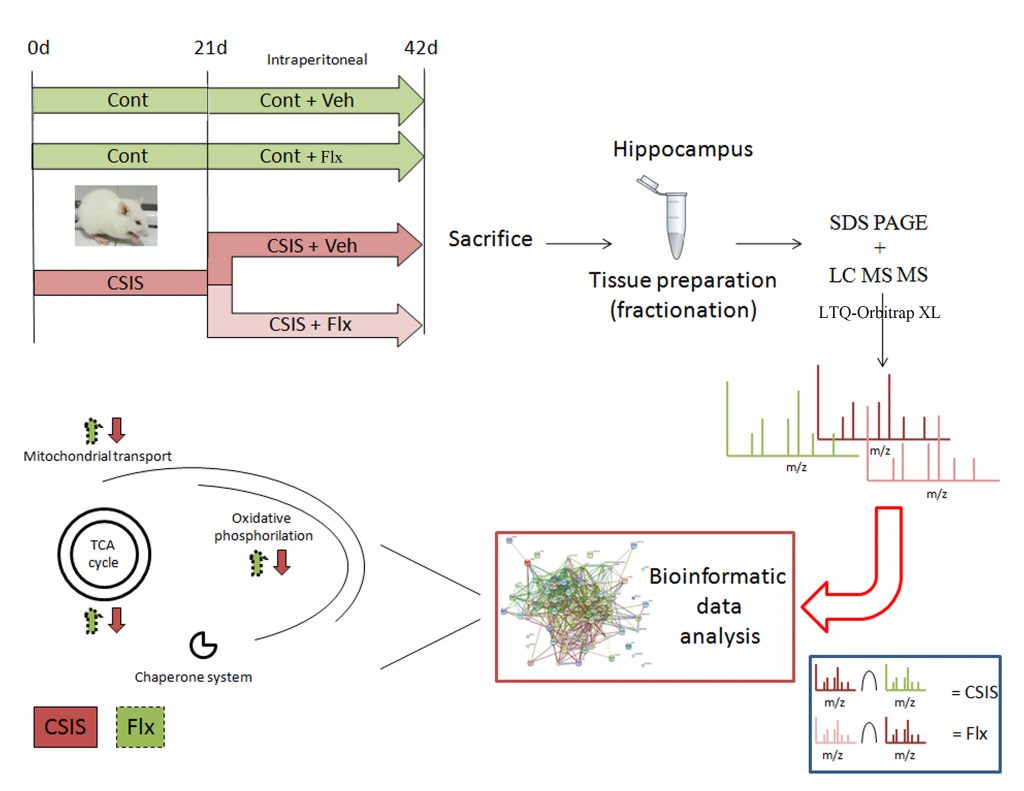Research topics
Stress, mental disorders and the effect of pharmacological substances
- Topic Manager: Dragana Filipović
- Associates:

- Research Summary:
The increasing prevalence of major depressive disorder worldwide requires more effectiveness in therapy approaches and the clarification of the mechanism of action of antidepressants. Hence, our research is focused on examining the biochemical basics of depressive-like behavior in adult male rats previously exposed to chronic social isolation (6 weeks), an animal model of depression and schizophrenia, as well as the antidepressant/antipsychotic effect of chronic drug use with different chemical structures, by comparing the changes at the protein level of GABAergic signaling and activation of neurons, as well as proteomic and metabolic profiles of fractions in different brain regions. The aim of the research is to identify the changes in the levels of specific proteins and metabolites, as parts of (specialized) biochemical pathways, whose (normal) functioning has been changed under chronic social isolation and/or as a result of chronic treatment with antidepressants/antipsychotics. The ultimate goal is to identify the panel of proteins as the underlying pathophysiology cause of the social isolation-induced depressive-like behavior and potential targets of effective antidepressants therapy, which would be important in the creation of new drugs with more successful therapeutic action.
- Publications:
- Perić I, Costina V, Djordjević S, Gass P, Findeisen P, Dragoš I, Borgwardt S, Filipović D. 2021. Tianeptine modulates synaptic vesicle dynamics and favors synaptic mitochondria processes in socially isolated rats. Scientific Reports, 11(1):17747.
- Filipović D, Perić I, Costina V, Stanisavljević A, Gass P, Findeisen P. 2020. Social isolation stress-resilient rats reveal energy shifts from glycolysis to oxidative phosphorylation in hippocampal nonsynaptic mitochondria. Life Sciences, 254, 117790.
- Stanisavljević A, Perić I, Inta D, Gass P, Lang E.U, Borgwardt S, Filipović D. 2019. Brain sub/regions-specific effects of olanzapine on c-Fos expression of chronically socially isolated rats. Neuroscience, 396, 46-65.
- Filipović D, Stanisavljević A, Jasnić N, Bernardi RE, Inta D, Perić I, Gass P. 2018. Chronic Treatment with Fluoxetine or Clozapine of Socially Isolated Rats Prevents Subsector-Specific Reduction of Parvalbumin Immunoreactive Cells in the Hippocampus. Neuroscience, 371, 384-394.
- Filipović D, Todorović N, Bernardi R, Gass P. 2017. Oxidative and nitrosative stress pathways in the brain of socially isolated adult male rats demonstrating depressive- and anxiety-like symptoms. Brain Structure and Function, 222(1), 1-20.
- Cooperations:
- Central Institute of Mental Health, Department of Psychiatry and Psychotherapy, Medical Faculty Mannheim, Heidelberg University, Germany
- Institute for Clinical Chemistry, Medical Faculty Mannheim of the University of Heidelberg (IKC Mannheim), Germany
- Max-Planck Institute of Psychiatry, Munich, Germany
- University of Lübeck, Germany
- Faculty of Chemistry, University of Belgrade, Serbia


